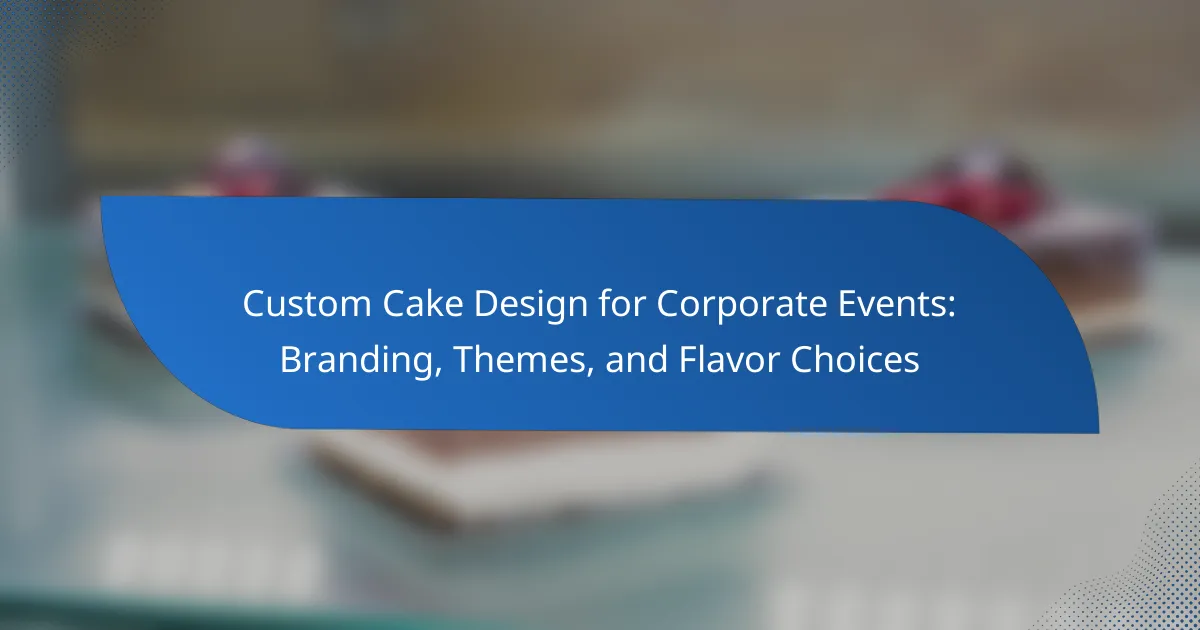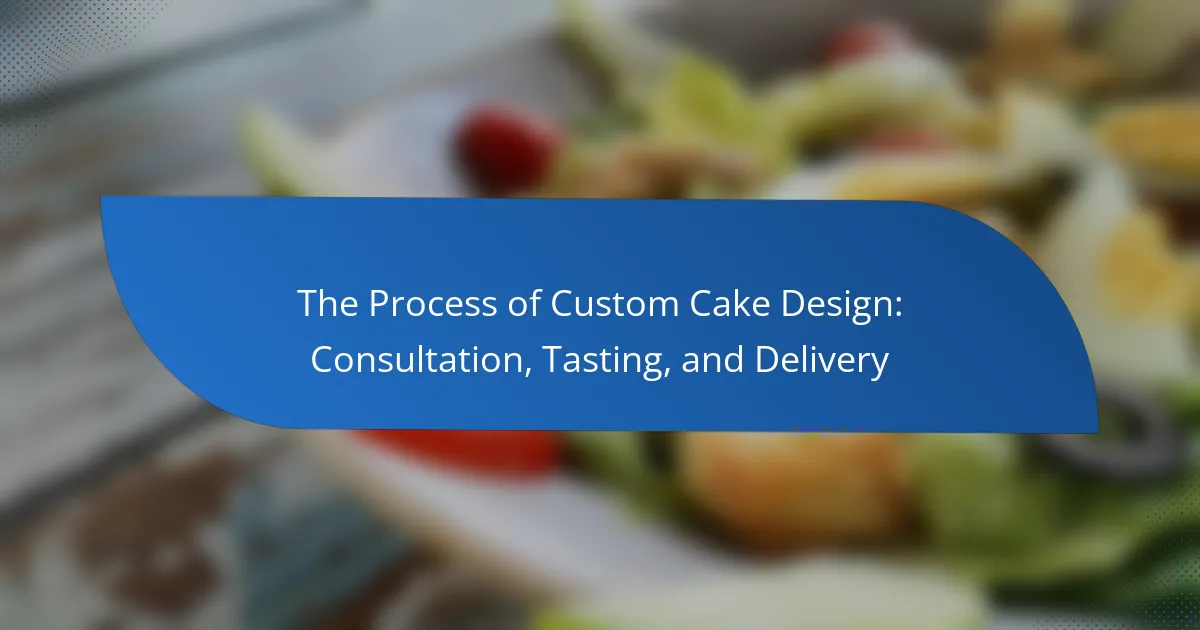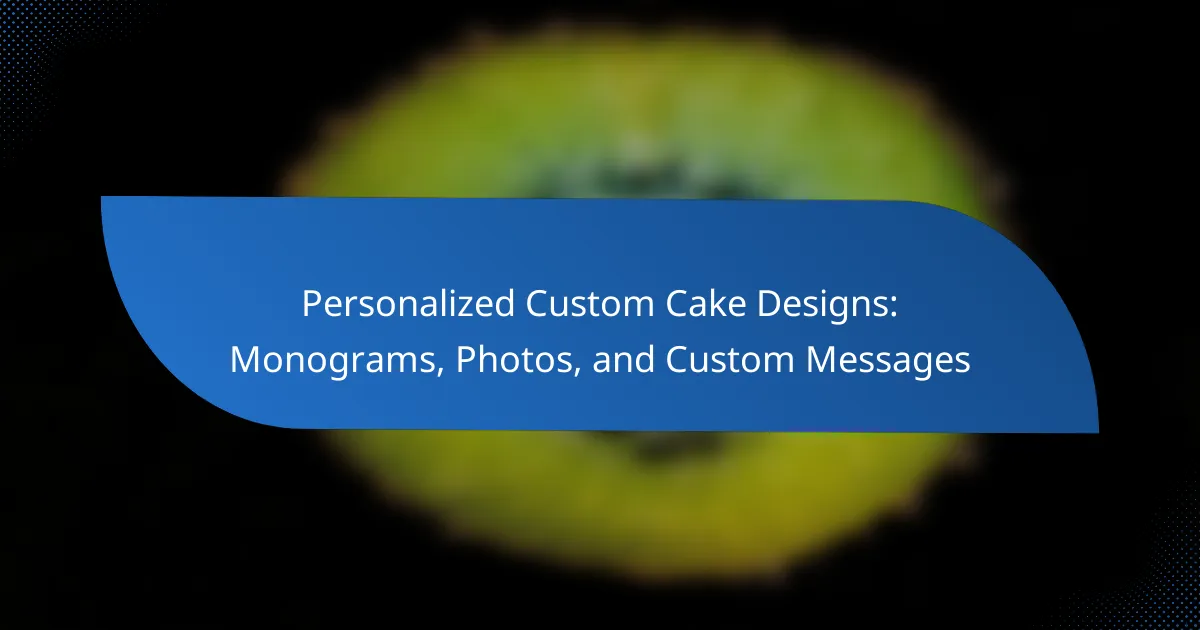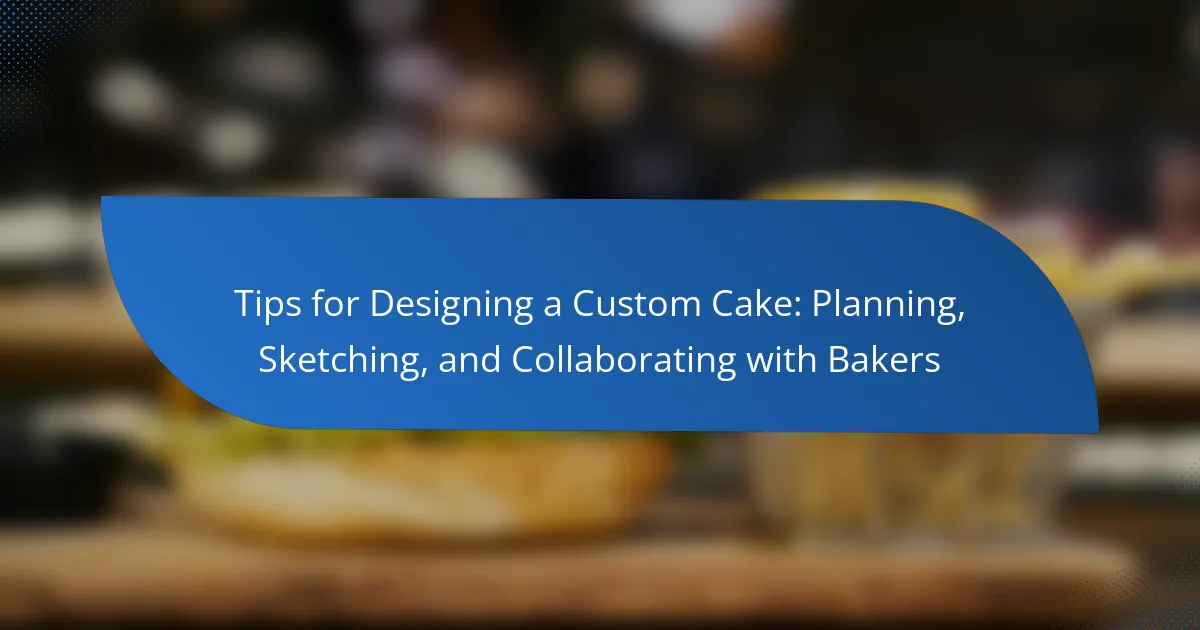Choosing the perfect custom cake design involves several key considerations, including the occasion, preferred style, and budget. Begin by defining the event type, such as a birthday or wedding, and exploring various cake designs that align with your theme and color preferences. Establishing a budget is essential, as it influences design choices and size options. Effective communication with a professional baker is crucial, as it ensures that your ideas and dietary needs are clearly conveyed, allowing for a tailored cake that meets your expectations. Additionally, reviewing sketches and conducting tastings can further refine your selection, ensuring the final cake is both visually appealing and delicious.
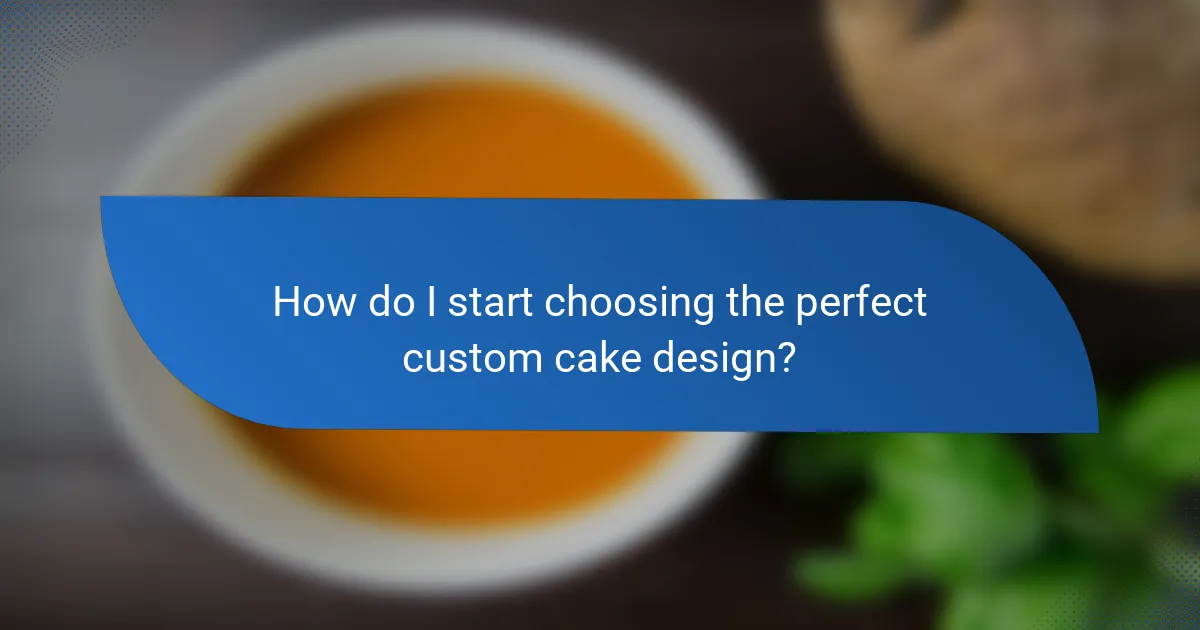
How do I start choosing the perfect custom cake design?
Start by defining the occasion for the custom cake. Consider the event type, such as a birthday or wedding. Next, identify the preferred cake style. Research various designs, including themes and color schemes. Determine your budget for the cake. This will guide your design choices and size options. Collect inspiration from online platforms or cake galleries. Finally, consult with a professional baker to discuss your ideas and preferences. Their expertise can help refine your choices and ensure feasibility.
What factors should I consider when selecting a cake size?
Consider the number of guests when selecting a cake size. The cake should serve all attendees. A standard serving size is typically one slice per person. Account for additional servings if guests may want seconds. Also, consider the event type. Weddings often require larger cakes than birthday parties. The cake’s design can influence size. Intricate designs may necessitate a larger base for stability. Lastly, budget constraints can dictate size. Larger cakes generally cost more due to ingredients and labor.
How do guest numbers influence cake size choices?
Guest numbers directly influence cake size choices by determining the amount of servings needed. A larger guest list requires a bigger cake to ensure everyone is served. For example, a standard serving size is typically one slice per person. Therefore, if there are 50 guests, a cake that serves at least 50 slices is necessary.
Bakeries often use formulas to calculate cake sizes based on guest counts. A common guideline is that a 6-inch cake serves about 12 people, while an 8-inch cake serves approximately 20. Thus, knowing guest numbers helps in selecting the right cake dimensions.
Additionally, the type of event can also affect cake size choices. Weddings usually have larger cakes than birthday parties due to higher guest counts. Accurate guest estimates are crucial for avoiding cake shortages or excess. This ensures a satisfying experience for all attendees.
What are the common sizes available for custom cakes?
Common sizes available for custom cakes include 6-inch, 8-inch, 10-inch, and 12-inch rounds. These sizes typically serve different numbers of guests. A 6-inch cake usually serves about 6 to 8 people. An 8-inch cake can serve approximately 10 to 12 guests. A 10-inch cake generally serves around 14 to 16 people. Lastly, a 12-inch cake can accommodate about 20 to 24 guests. Custom cakes can also be made in sheet sizes, such as quarter, half, and full sheets. These sizes offer more servings and can be tailored to specific events.
What styles of custom cakes are popular?
Popular styles of custom cakes include fondant cakes, buttercream cakes, and [censured] cakes. Fondant cakes are known for their smooth, polished appearance. They allow for intricate designs and shapes. Buttercream cakes are favored for their rich flavor and creamy texture. They are easier to decorate and can be styled in various ways. [censured] cakes feature minimal frosting, showcasing the layers and fillings. They have a rustic charm and are popular for weddings and casual events. Other popular styles include themed cakes, which reflect specific interests or occasions, and tiered cakes, which create a dramatic visual impact.
How do I choose a cake style that matches my event theme?
To choose a cake style that matches your event theme, first identify the theme’s key elements. Consider colors, motifs, and overall ambiance. For a formal event, opt for elegant designs like fondant or tiered cakes. Casual events may suit whimsical or themed cakes. Match cake flavors to the theme; for example, a tropical theme pairs well with fruit flavors. Review images of cakes that fit your theme for inspiration. Consult with a baker who specializes in custom designs to refine your choices. Their expertise can help align your vision with practical execution.
What are the different types of cake styles available?
The different types of cake styles available include classic, modern, and themed cakes. Classic cakes often feature traditional flavors and simple designs. Modern cakes may incorporate unique shapes and contemporary decorations. Themed cakes are designed to reflect specific events or interests. Other styles include tiered cakes, single-layer cakes, and sculpted cakes. Each style can be customized with various flavors and fillings. Customization allows for personalization based on the occasion. Popular cake flavors include vanilla, chocolate, and red velvet. These options cater to diverse preferences and celebrations.
Why is budgeting important when choosing a custom cake?
Budgeting is important when choosing a custom cake because it determines the options available to the buyer. A clear budget helps narrow down choices based on cost constraints. Custom cakes can vary widely in price due to factors like size, design complexity, and ingredient quality. Knowing the budget allows for realistic expectations regarding these factors. For example, a simple design may cost around $3 per slice, while an intricate one could exceed $10 per slice. Without a budget, buyers may overspend or compromise on quality. Establishing a budget also aids in effective communication with bakers about desired features. This ensures that the final product aligns with both financial and aesthetic expectations.
How can I determine my budget for a custom cake?
To determine your budget for a custom cake, first, identify the key factors that influence cost. These factors include size, design complexity, and ingredients. Custom cakes typically range from $3 to $10 per serving. The size of the cake directly affects the total cost; larger cakes require more ingredients and time. Design complexity increases labor and material costs. For example, intricate decorations or specialty flavors can raise the price significantly. Additionally, consider any delivery fees or rental costs for cake stands. Research local bakeries to compare prices and services. This approach ensures you set a realistic budget based on your specific needs and preferences.
What factors affect the cost of a custom cake?
The cost of a custom cake is affected by several key factors. The size of the cake significantly influences the price. Larger cakes require more ingredients and labor, increasing costs. The complexity of the design also plays a vital role. Intricate designs take more time and skill to create, which raises the price. The choice of ingredients impacts the cost as well. High-quality or specialty ingredients can lead to higher expenses. Additionally, the location of the bakery can affect pricing due to local market rates. Delivery fees may also be added, especially for long distances. Finally, the experience level of the baker can influence the price; seasoned bakers often charge more for their expertise.

How can I ensure my custom cake meets my expectations?
To ensure your custom cake meets your expectations, communicate clearly with your baker. Provide detailed information about your desired flavors, designs, and any dietary restrictions. Share reference images to illustrate your vision. Discuss the size and number of servings needed for your event. Establish a budget upfront to guide the design process. Request a tasting session to evaluate flavors before finalizing the order. Confirm all details in writing to avoid misunderstandings. Lastly, maintain open communication leading up to the event to address any last-minute changes or questions.
What should I communicate to the cake designer?
Communicate the cake’s size, style, and budget to the cake designer. Specify the number of servings required for accurate sizing. Describe the desired design elements, such as colors and themes. Discuss any dietary restrictions or preferences, like gluten-free or vegan options. Share your budget to align expectations. Provide any inspirational images to clarify your vision. Confirm the event date to ensure availability. Discuss delivery and setup requirements for the cake.
How do I share my vision effectively with the designer?
To share your vision effectively with the designer, clearly articulate your ideas and preferences. Start by providing a detailed description of your desired cake design. Include specifics about size, style, and colors. Visual references, such as images or sketches, can enhance understanding. Discuss any themes or occasions related to the cake. Be open to the designer’s input and suggestions. This collaborative approach ensures alignment. Effective communication leads to a successful design outcome. Studies show that clear communication reduces misunderstandings in creative projects.
What details are crucial to include in my cake order?
Crucial details to include in your cake order are the size, flavor, design, and any special dietary requirements. Specify the number of servings needed to determine the cake size. Choose a flavor that appeals to you and your guests. Describe the design, including colors and themes, to guide the baker. Mention any allergies or dietary restrictions, such as gluten-free or vegan needs. Provide the date and time for the cake delivery or pickup. Lastly, include any additional notes, such as message or decoration preferences. These details ensure the cake meets your expectations and requirements.
How do I evaluate the quality of a custom cake?
To evaluate the quality of a custom cake, assess its ingredients, taste, and presentation. High-quality cakes use fresh, premium ingredients like real butter and natural flavorings. Taste is crucial; the cake should be moist and flavorful. Check for even texture and proper sweetness. Presentation matters as well; the design should be clean and visually appealing. Additionally, consider the cake’s structural integrity; it should hold its shape and not collapse. Customer reviews and recommendations can provide insight into a baker’s consistency and quality.
What should I look for in cake tastings?
When attending cake tastings, look for flavor variety and texture. Each cake should have distinct flavors that appeal to your palate. Pay attention to the moisture level; a good cake should be moist and tender. Evaluate the sweetness; it should be balanced, not overwhelming. Also, assess the frosting; it should complement the cake without being too heavy. Consider the presentation; an aesthetically pleasing cake indicates attention to detail. Lastly, ask about ingredient quality; high-quality ingredients enhance flavor and texture.
How can I assess a designer’s portfolio?
To assess a designer’s portfolio, start by reviewing the variety of work presented. Look for diversity in styles and techniques that demonstrate creativity. Evaluate the quality of the designs, ensuring they are visually appealing and professionally executed. Check for consistency in the designer’s signature style across different projects. Consider the relevance of the portfolio to your specific needs, such as custom cake designs. Look for testimonials or case studies that highlight client satisfaction. Finally, assess how well the designer communicates their process and ideas, as this reflects their professionalism.
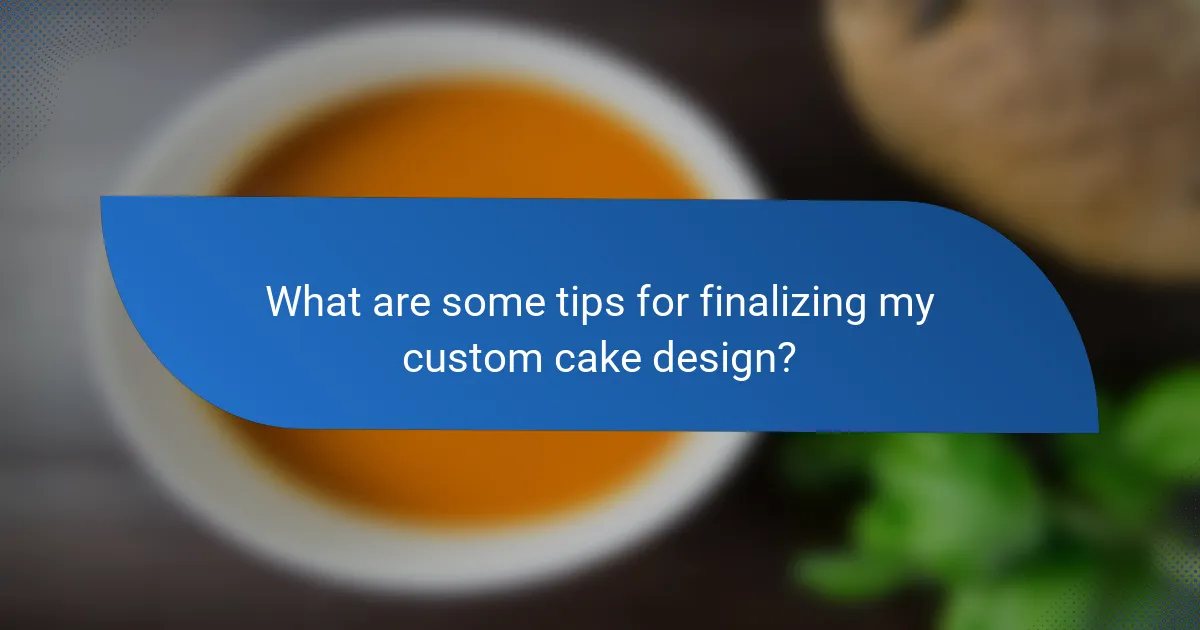
What are some tips for finalizing my custom cake design?
To finalize your custom cake design, begin by confirming the theme and color scheme. Ensure that the design aligns with the event’s overall aesthetic. Next, discuss specific flavors and fillings with your baker. This step is crucial for taste and presentation. Review any sketches or mock-ups provided by the baker. This allows for adjustments before the final creation. Consider the cake’s size in relation to the guest count. A cake that is too small may not serve everyone. Finally, set a budget and communicate it clearly. This helps the baker suggest options that fit within your financial plan.
How can I make last-minute adjustments to my cake order?
Contact the bakery directly as soon as possible. Provide your order details and specify the adjustments needed. Most bakeries can accommodate changes if notified promptly. Changes may include size, flavor, or design elements. Confirm if the adjustments affect the price or delivery time. Many bakeries have policies for last-minute changes. Check if there are any additional fees for modifications. Acting quickly increases the likelihood of successful adjustments.
What should I do if my budget changes before the event?
Reassess your cake design options if your budget changes before the event. Begin by identifying essential elements of the cake. Consider modifying the size or complexity of the design. Explore alternative flavors or fillings that may be more cost-effective. Communicate with your cake designer about your budget constraints. They can provide suggestions that align with your new budget. Adjusting your expectations can lead to a satisfactory outcome. Maintaining flexibility is key to finding a suitable solution.
How can I ensure timely delivery of my custom cake?
To ensure timely delivery of your custom cake, place your order well in advance. Most bakeries require at least a week’s notice for custom cakes. Communicate your desired delivery date clearly when ordering. Confirm the bakery’s delivery policies and options. Provide accurate delivery details, including the address and contact information. Follow up a day before the delivery to confirm the order status. Timely communication helps avoid last-minute issues. According to industry standards, early planning minimizes the risk of delays.
What common mistakes should I avoid when ordering a custom cake?
Common mistakes to avoid when ordering a custom cake include not providing clear specifications. Customers often forget to mention dietary restrictions, which can lead to unsuitable ingredients. Failing to communicate the desired flavor can result in a disappointing cake. Many also underestimate the size needed for their event, leading to insufficient servings. Not allowing enough lead time for the cake to be made can cause stress and rushed results. Additionally, neglecting to review the cake designer’s portfolio may lead to mismatched expectations. Lastly, not confirming the final details before the order is placed can result in errors.
How can I prevent miscommunication with the cake designer?
To prevent miscommunication with the cake designer, provide clear and detailed information about your expectations. Specify the cake size, flavor, and design elements you desire. Use reference images to illustrate your vision. Confirm the timeline for the cake delivery or pickup. Discuss the budget upfront to avoid misunderstandings. Regularly check in with the designer during the process for any updates or clarifications. Document all agreements in writing to ensure both parties are on the same page. This approach minimizes the risk of errors and ensures satisfaction with the final product.
What are the pitfalls of rushing the cake design process?
Rushing the cake design process can lead to several significant pitfalls. First, it may result in poor planning and inadequate preparation. This can cause mismatched flavors and designs that do not meet expectations. Additionally, rushing often compromises the quality of ingredients used. Subpar ingredients can negatively affect the taste and texture of the cake.
Moreover, time constraints can limit creativity. This can lead to generic designs that lack personalization. Mistakes become more likely when time is short. Errors in measurements or decoration can occur, leading to a final product that is less than satisfactory.
Finally, a rushed process can increase stress for both the baker and the client. This can result in miscommunication about preferences and requirements. A well-thought-out design process is essential for a successful cake that fulfills the client’s vision.
The main entity of this article is custom cake design. The article provides a comprehensive guide on selecting the perfect custom cake by addressing key considerations such as occasion, size, style, and budget. It outlines the factors influencing cake size based on guest numbers, popular styles of cakes, and the importance of budgeting in the decision-making process. Additionally, the article emphasizes effective communication with bakers to ensure the final product meets expectations and offers tips for avoiding common pitfalls in the cake ordering process.
